Shining a new light on 50+ tourism with our choice-based segmentation protocol
The 50+ demographic has always been a critically important group for the tourism industry. Estimates are, one third of all trips are taken by tourists who are over 50.
discover moreNovember 24, 2021
Shining a new light on 50+ tourism with our choice-based segmentation protocol
The travel sector is experiencing an unmitigated disaster. Global tourism losses since the beginning of the COVID-19 pandemic are estimated to reach four trillion dollars of global GDP by the end of 2021. Tourism revenues are down between 60 and 80 percent across major regions of the globe.
This enormous loss of revenue will not be easily regained. Through the pandemic, many travellers have focused more on domestic travel, and concerns about the risks of travel (international travel in particular) remain a key barrier to returning to pre-pandemic levels. Significant changes to the sector include marked decline in international travel, increased demand for travel insurance, greater reliance on knowledgeable travel advisors, and short-term rentals closer to home. Concerns about safety on cruise lines and all-inclusive resorts will take a long time to recede.
The 50+ demographic has always been a critically important group for the tourism industry. Estimates are, one third of all trips are taken by tourists who are over 50, though they account for only one quarter of the global population. Historically, tourism marketing has focused more on Millennials, and promoting 50+ tourism has often been done badly, or as an afterthought. As our population ages, older travellers will continue to grow in importance and value (Checkfront – May 2021). Many seniors have more travel time and funds available to spend. Older travellers, while well-positioned economically, are more at risk for infection and are hesitant to go back to business-as-usual in the short term.
As the sector recovers, it is critically important to take a fresh look at traveller groups so that the best possible recovery can be made. In the past, the 50+ tourism market has not been well understood nor its complexity fully recognized.

RESEARCH STRATEGY GROUP has a number of approaches to help generate a fresh and more accurate picture of this key tourism demographic. For example, our validated choice-based segmentation protocol can help clients to better understand older travellers and drive recovery by identifying new opportunities and reinforcing new patterns.
Our protocol consists of four vital stages. First, we work with client stakeholders upfront to ensure that we will be addressing the objectives and learning needs they feel are most important. Next, we leverage qualitative research to derive a deeper understanding of the target group. Typically, we employ psychoanalytic techniques, such as storytelling and image sorts, to create a hierarchy of conscious and unconscious needs. We also interpret results through a behavioural science lens to uncover cognitive biases that might be impacting behaviours. The overall purpose is to build a foundational understanding of deeper, often unconscious needs and motivations of the identified target to better predict behaviour.
Following this, we leverage qualitative learnings to generate batteries of statements about current and future needs related to travel and tourism to inform a quantitative phase using our sophisticated, predictive choice-based approach. As a result, our segmentation is based on what really matters and what is driving behaviour. Instead of ratings scales, we ask respondents to pick whichever statements best describe them. This results in less “muddy” data and more clearly defined, distinct consumer segments.
The derived segments are highly accurate and reproducible. In addition to the current and future oriented attribute lists, our survey includes detailed demographics and behavioural data. In the case of the 50+ traveller, we ideally end up with 4-6 distinct segments, each defined by the statements for which they were most different from the other segments. For example, the solution might identify a 50+ tourist group that tends to travel overland and domestically. They may spend less on accommodations and more on attractions. Another segment might include older adventure travellers who tend to spend much more on travel and have higher expectations than other segments. This segment might also be more likely reading about their destination in advance, including peer reviews on the operator. Our segments are easily distinguishable, relatable, and make intuitive sense.
Segmenting 50+ tourists with our approach delivers several benefits including:
- Estimates of the size and value of each segment to support market planning and focus
- Detailed profiles of travel habits for each segment to support proper targeting of products and services
- Clear differentiation of the needs and attitudes of different segments to support the development of relevant and motivating communications
- Actionable understanding of influence channels to help maximize the effectiveness of media placement and expenditures
Deliverables such as these will help you develop a new, rich understanding of 50+ tourists on which to base effective, targeted growth strategies.
In the final stage, we socialize research findings within the client organization – typically through workshops with key internal groups. Workshop sessions help our client partners to capitalize on new opportunities within the target group and move away from outdated notions and truisms.
We at RESEARCH STRATEGY GROUP look forward to exploring how we can enhance your understanding of 50+ travellers, and other consumers, for your brand. Please get in touch!
Anne Coulter, Managing Director annecoulter@rsginc.net
Jim Peterson, Managing Director jimpeterson@rsginc.net




Comments are closed.